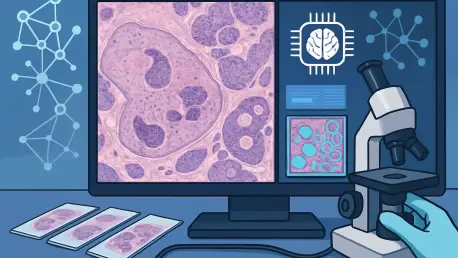In a world where healthcare faces mounting pressures from rising case complexity and a shrinking pool of pathologists, a quiet revolution is unfolding that could change the game entirely. Digital pathology, the transition from traditional glass slides under microscopes to high-resolution digital images powered by artificial intelligence (AI), is no longer a futuristic concept but a tangible shift happening across labs and hospitals. This transformation addresses critical challenges in diagnostics by offering faster, more accurate results and enabling seamless collaboration among experts, regardless of location. What makes this moment particularly striking is the consensus among industry leaders that a tipping point has been reached, where technology and necessity converge to push digital pathology into the mainstream.
This evolution, built on decades of innovation, hinges on tools like whole slide imaging (WSI) scanners that digitize physical slides into detailed images accessible from anywhere. These advancements are not merely about replacing outdated methods; they’re about unlocking data for deeper analysis and integrating it with other patient information. The result is a system that empowers pathologists to handle growing workloads with greater precision. However, the path to full adoption isn’t without obstacles—high costs, regulatory complexities, and resistance to change pose significant hurdles. Despite these challenges, the momentum is undeniable, as major institutions and companies alike invest heavily in scaling digital solutions to reshape healthcare delivery.
The Technological Backbone of Digital Pathology
Scanning the Future: Whole Slide Imaging Advancements
The foundation of digital pathology lies in the remarkable progress of whole slide imaging scanners, which have transformed the way diagnostic images are created and accessed. These devices, now capable of producing high-resolution digital slides at a fraction of their earlier costs, have made digitization a viable option for labs of varying sizes. Institutions like Mayo Clinic have already digitized millions of slides, demonstrating how automation and robotics streamline the process and reduce manual labor. This scalability is critical, as it turns once-static analog slides into dynamic digital assets that can be stored, shared, and analyzed with unprecedented ease. Beyond merely replacing microscopes, WSI technology represents a gateway to a data-rich environment where diagnostic potential is vastly expanded.
Equally significant is the impact of declining costs and improved accessibility on the broader adoption of these tools. As scanner technology becomes more affordable, smaller hospitals and clinics, previously deterred by budget constraints, are beginning to integrate digital systems into their workflows. This democratization of technology is accelerating the shift away from traditional methods, allowing even resource-limited settings to benefit from enhanced image quality and storage solutions. Moreover, the integration of cloud-based platforms with WSI scanners ensures that digital slides are not confined to a single location, enabling pathologists to access critical data from virtually anywhere. This technological leap is a cornerstone of the ongoing revolution, setting the stage for further innovations in diagnostics.
Beyond the Microscope: Data Integration
Digital pathology extends far beyond the act of digitizing slides; it’s fundamentally about creating a connected ecosystem where data from various sources converges for better patient outcomes. By linking digital images with electronic health records and other clinical information, pathologists gain a more comprehensive view of a patient’s condition. This holistic approach allows for correlations that were previously impossible with isolated slide analysis, such as identifying patterns across a patient’s medical history. The ability to overlay imaging data with other metrics offers a deeper understanding of diseases, paving the way for diagnoses that are not only accurate but also contextually informed by a broader dataset.
This integration also fosters a new level of interoperability within healthcare systems, breaking down silos that often hinder efficient care delivery. Digital pathology platforms enable seamless data sharing among departments and even across institutions, ensuring that critical insights are available when and where they’re needed most. For instance, a digitized slide can be paired with genetic testing results to tailor treatment plans, a synergy that enhances precision medicine. As these systems evolve, the potential to incorporate real-time updates from wearable devices or ongoing lab results could further refine diagnostic accuracy. The shift to an integrated data framework marks a significant departure from the fragmented practices of the past, positioning digital pathology as a vital component of modern healthcare infrastructure.
AI: The Brain Behind the Image
Predictive Power: AI in Diagnostics
Artificial intelligence has emerged as a transformative force in digital pathology, pushing diagnostic capabilities beyond the limits of human analysis with remarkable precision. By sifting through vast datasets, AI algorithms can identify subtle patterns and biomarkers that might escape even the most trained eyes, offering predictions on patient outcomes that inform critical treatment decisions. For example, models developed by companies like Owkin demonstrate the ability to predict breast cancer relapse or screen for colorectal cancer risks, providing actionable insights at a scale previously unimaginable. This predictive power is especially valuable in complex cases where early intervention can significantly alter a patient’s prognosis, highlighting AI’s role as a pivotal tool in advancing medical science.
Furthermore, AI’s capacity to enhance objectivity in diagnostics addresses long-standing challenges in subjective interpretation, offering a transformative approach to medical assessments. In borderline cases, where human judgment can vary widely, AI tools provide consistent, data-driven assessments that reduce diagnostic discrepancies. These systems are also adept at identifying specific markers, such as PD-L1 expression levels for immunotherapy eligibility, ensuring that patients receive therapies best suited to their unique profiles. Collaborations between major institutions like Mayo Clinic and tech giants further amplify this potential, with foundation models trained on massive datasets paving the way for specialized diagnostic applications. The integration of AI into pathology is not just an enhancement—it’s a redefinition of what’s possible in disease detection and management.
Automating the Mundane: Workflow Support
While AI’s role in deep analysis garners much attention, its ability to streamline routine tasks is equally impactful in easing the burden on pathologists. Tools powered by AI can automatically assess slide quality, flag potential errors, and prioritize cases based on urgency, saving valuable time in high-pressure environments. Partnerships, such as the one between Quest Diagnostics and PathAI, exemplify how these capabilities are already being deployed to handle repetitive aspects of diagnostic workflows. By automating these mundane processes, pathologists are freed to focus on more intricate analyses, ensuring that their expertise is directed where it’s most needed. This shift not only boosts efficiency but also helps mitigate the effects of workforce shortages in the field.
Additionally, the automation provided by AI contributes to consistency across diagnostic processes, a critical factor in maintaining high standards of care. Routine checks that might be overlooked during busy periods are now reliably managed by algorithms, reducing the risk of oversight. This reliability extends to case triaging, where AI can quickly identify which slides require immediate attention, ensuring that urgent diagnoses are not delayed. As these tools become more integrated into daily operations, they also offer scalability, allowing labs to handle larger volumes of cases without compromising on quality. The practical benefits of AI in workflow support underscore its dual role as both an innovator and a facilitator in the digital pathology landscape, reshaping how labs operate on a fundamental level.
Breaking Barriers: Collaboration and Efficiency
Global Reach: Instant Expertise
One of the most profound benefits of digital pathology is its ability to dissolve geographic barriers, enabling pathologists to tap into global expertise with just a few clicks. Gone are the days of waiting for physical slides to be shipped across cities or countries for a second opinion; digital images can now be shared instantly across hospital networks or even international borders. This immediacy ensures that patients, regardless of their location, have access to top-tier diagnostic input without delay. A specialist in a major urban center can review a slide scanned in a remote clinic, providing critical insights that might otherwise be out of reach. This connectivity is revolutionizing consultation processes, making expert collaboration a standard rather than an exception.
The implications of this global reach extend beyond individual patient care to the broader advancement of medical knowledge, highlighting the transformative power of technology in healthcare. Digital pathology platforms facilitate the creation of virtual networks where pathologists can discuss rare or challenging cases in real time, fostering a collective learning environment. Such collaboration not only improves diagnostic accuracy but also accelerates the dissemination of new findings and techniques across the field. For regions with limited access to specialized pathologists, this technology serves as a lifeline, bridging gaps in expertise and ensuring equitable care delivery. The ability to connect instantly with peers worldwide is a testament to how digital pathology is redefining the very structure of medical consultation, making it more inclusive and responsive.
Streamlined Operations: Time-Saving Tools
Efficiency in pathology workflows has taken a significant leap forward thanks to digital tools that cut down on diagnostic turnaround times. By automating routine steps such as slide preparation checks and case prioritization, these systems allow pathologists to manage heavier caseloads without sacrificing accuracy. Real-world applications, such as those implemented by Quest Diagnostics, demonstrate how AI-driven tools can quickly sort through incoming cases to highlight those needing urgent attention. This streamlined approach ensures that critical diagnoses are expedited, directly benefiting patients who require immediate intervention. The time saved through these innovations translates into a more responsive healthcare system, capable of meeting growing demands.
Moreover, the operational benefits of digital pathology extend to resource allocation within labs, optimizing how limited personnel and equipment are utilized. With repetitive tasks handled by automated systems, staff can dedicate more time to complex analyses and research initiatives, enhancing overall productivity. This efficiency also reduces the likelihood of burnout among pathologists, a pressing concern given the field’s staffing shortages. As digital tools continue to refine workflow processes, they create a ripple effect, improving not just speed but also the quality of diagnostic output. The transformation of lab operations through these time-saving mechanisms underscores digital pathology’s potential to address systemic challenges, ensuring that healthcare delivery keeps pace with escalating needs.
Challenges on the Horizon
Cost and Access: Financial Hurdles
Despite the promise of digital pathology, the financial barriers to its adoption remain a significant challenge for many institutions, especially as the upfront costs of acquiring WSI scanners, securing cloud storage, and implementing AI tools can be prohibitive. This is particularly true for smaller hospitals or clinics operating on tight budgets. Compounding this issue is the lack of direct reimbursement models for digital pathology services, which makes it difficult for organizations to justify the investment. Although costs are gradually decreasing as technology becomes more widespread, the initial financial burden continues to slow the pace of adoption, limiting access to cutting-edge diagnostics in under-resourced settings.
Additionally, the economic challenges are not just about hardware but also about the ongoing expenses tied to maintenance and system upgrades. Digital pathology requires continuous investment in cybersecurity to protect sensitive patient data, as well as in training staff to use new platforms effectively. Without a clear path to financial sustainability, many institutions hesitate to commit fully to digitization, even when the long-term benefits are evident. Addressing these cost-related obstacles will require innovative funding models, such as public-private partnerships or tiered pricing structures, to ensure that the advantages of digital pathology are not confined to well-funded entities. Bridging this financial gap is essential to realizing the technology’s full potential across diverse healthcare landscapes.
Rules and Resistance: Regulatory and Cultural Barriers
Navigating the regulatory landscape presents another formidable hurdle for digital pathology, particularly when it comes to AI algorithms that evolve over time, creating significant challenges for developers. Traditional approval processes are often rigid, designed for static technologies rather than adaptive systems, which creates friction in the deployment of cutting-edge tools. This mismatch delays the integration of AI-driven diagnostics into clinical practice, as developers and regulators grapple with how to ensure safety without stifling innovation. Experts from various organizations have noted that these regulatory challenges require a rethinking of current frameworks to accommodate the dynamic nature of digital solutions, a process that could take years to fully resolve.
Equally challenging is the cultural resistance among pathologists accustomed to traditional methods, many of whom are skeptical about transitioning to digital workflows. Shifting from microscopes to screens involves a steep learning curve, and the reluctance to abandon trusted practices can slow adoption. However, success stories from places like Mayo Clinic show that with proper training and exposure, even the most hesitant professionals can become advocates for digital tools. Overcoming this resistance demands not just technical support but also a focus on demonstrating tangible benefits, such as reduced workloads and improved accuracy. Tackling both regulatory and cultural barriers is crucial to ensuring that digital pathology moves from a promising concept to a widely accepted standard in medical diagnostics.
Looking Forward: The Future of Digital Pathology
Market Growth: A Maturing Landscape
The digital pathology market is showing clear signs of maturation, with the entry of major players like Roche Diagnostics and Leica Biosystems signaling a shift from a startup-driven field to one dominated by established industry giants. This evolution brings with it a wave of tailored solutions designed to meet the diverse needs of hospitals, research facilities, and diagnostic labs. As competition intensifies, costs are expected to continue declining, making digital tools more accessible to a wider range of institutions. This trend points to a future where digital pathology becomes the default approach rather than a specialized option, fundamentally altering the diagnostic landscape over the coming years.
Beyond accessibility, the maturing market is also fostering greater innovation in product offerings, with companies developing systems that cater to specific clinical or research requirements. For instance, advancements in integration capabilities are allowing digital pathology platforms to sync seamlessly with existing hospital information systems, reducing implementation friction. This growth is further supported by increasing investment from both private and public sectors, recognizing the technology’s potential to address systemic healthcare challenges. As adoption scales, the standardization of digital practices across regions could emerge, creating a unified framework for diagnostics. The trajectory of market expansion suggests that digital pathology is poised to become an integral part of healthcare infrastructure, driving efficiency on a global scale.
Precision and Discovery: Expanding Horizons
Looking ahead, digital pathology holds immense promise for precision medicine, particularly through the development of AI-driven companion diagnostics that match patients with the most effective treatments. These tools, which analyze digital slides alongside genetic and clinical data, are set to play a central role in tailoring therapies to individual profiles, enhancing outcomes in areas like oncology. Experts predict significant growth in this space, with digitization becoming essential for modern drug development and personalized care. The ability to pinpoint biomarkers and predict treatment responses through integrated datasets positions digital pathology as a linchpin of future medical advancements, promising a more targeted approach to disease management.
Simultaneously, the research potential of digital pathology is opening new frontiers in understanding disease mechanisms, fueled by the integration of imaging with fields like genomics and proteomics. By layering digital slide data with electronic health records and other omics information, researchers can uncover insights into complex conditions that were previously out of reach. This data-rich environment also offers practical benefits, such as the flexibility of remote work, which is attracting new talent to the field by offering modern, adaptable career paths. As these horizons expand, the synergy between digital pathology and broader scientific inquiry could lead to groundbreaking discoveries, reshaping not just diagnostics but the entire spectrum of healthcare innovation.









